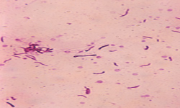Pathogen and transmission
Diphtheria is an infectious disease caused by the bacterium Corynebacterium diphtheriae. There are two types of diphtheria: respiratory (affecting the airways) and cutaneous (affecting the skin). The pathogen mainly affects the upper respiratory tract and produces a poison (diphtheria toxin) that can lead to dangerous complications and long-term damage. Human to human transmission takes place via droplet infection (close physical contact, coughing, sneezing). It is passed from someone who has the condition or is carrying the bacterium but not showing symptoms. More rarely, the infection is passed on from contaminated objects or, in the case of cutaneous diphtheria, direct contact.
Clinical picture
The disease generally begins gradually with a sore throat, fever and difficulty swallowing two to five days after transmission of the diphtheria bacteria. Later, hoarseness, wheezing and lymph node swelling occurs. An angina-like pharyngitis or tonsillitis occurs, typically with a grey-white, sweet-smelling coating that can spread from the roof of the mouth to the larynx and vocal cords (classic croup). This coating bleeds on removal and in some cases closes the airway to such an extent that the patient experiences severe breathing difficulties or even suffocates.
In infants and young children, nasal diphtheria is usually observed with purulent/bloody sneezing, leading to limited breathing through the nose, anxiety and reduced food intake. Rarely, cutaneous and wound diphtheria can occur, mainly in tropical areas.
In addition to these inflammations, the toxin produced by the bacteria can also lead to serious complications such as heart muscle inflammation, kidney and liver damage or paralysis, even weeks later. The mortality rate for throat diphtheria is high (up to 50 percent), but this can be reduced to 5-10 percent with careful administration of an antidote. At the same, the diphtheria bacterium is treated with antibiotics. Unvaccinated young children and older people are particularly at risk of a fatal outcome.
Distribution and frequency
Diphtheria is found all over the world, although it has largely vanished from industrialised countries thanks to the introduction of generalised vaccination. In regions and/or countries with lower vaccination coverage, such as Africa, Asia and Latin America, however, it does still occur.
Prevention
An extremely effective vaccination provides protection from the disease. It should be administered at 2, 4 and 12 months, then at 4 to 7 and 11 to 15 years. Additional booster shots are recommended at 25, 45 and 65 years (every twenty years) and then every ten years. Diphtheria vaccination is recommended in combination with vaccination against tetanus, pertussis, polio, Haemophilus influenzae type b, and hepatitis B, depending on age.
You can request further information on the global distribution and on prevention of the disease from your GP or a specialist in travel medicine.


